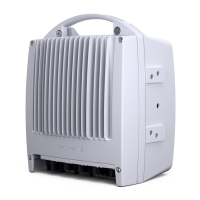MINI-LINKEandEMicro
3.3.2.4 Transmit IF Signal Processing
The input amplifier is automatically gain-controlled so that no compensation is
required due to the cable length between indoor and outdoor equipment.
The level is used to generate an alar m, indicating that the transmitting IF signal
level is too low due to excessive cabl e losses.
3.3.2.5 Transmitter Block
Upconver ter
The transmitt ing IF signal is amplified and up-converted to 7 GHz / 8 GHz
in the transmitter.
Transmitter Oscillator
The frequency of the transmitter is controlled in a Phase Locked Loop (PLL) (a
sample of the VCO signal is fed to a divider and fur ther on to a programmable
phase detector). The error signal is controlled by the integrated control and
super vision system by using a serial bus. An unlocked VCO loop generates a
transmitter frequency alar m .
Final Amplifier
The transmitter output power is controlled by adjusting the gain of the final
amplifier. The output power is set in steps of 1 dB through the operation and
maintenance system. The transmitter can be switched on or off by switching
the final amplifier.
3.3.2.6 Power Detector
A sample of the transmission signal is used for supervision of the transmitted
power (output power alarm).
3.3.2.7 RF Loop
A sample of the transm ission signal is m ixed with a shift oscillator signal and is
fed into the receiver for test purposes.
3.3.2.8 RF Attenuation
In addition to the transmitter output power control described above, the output
RF level may be fur t her decreased by fitting fixed RF attenuators to the
microwave unit. The transmitted RF can then be attenuated by a total of 50 dB.
See Section 8.1.1 on page 126 for more details.
28
AE/LZT 110 2012 R8C 2002-03-04

